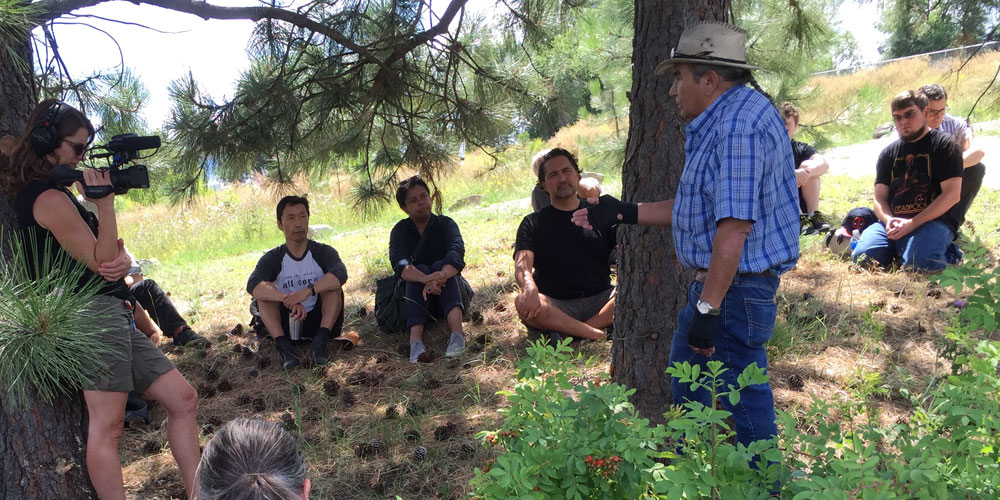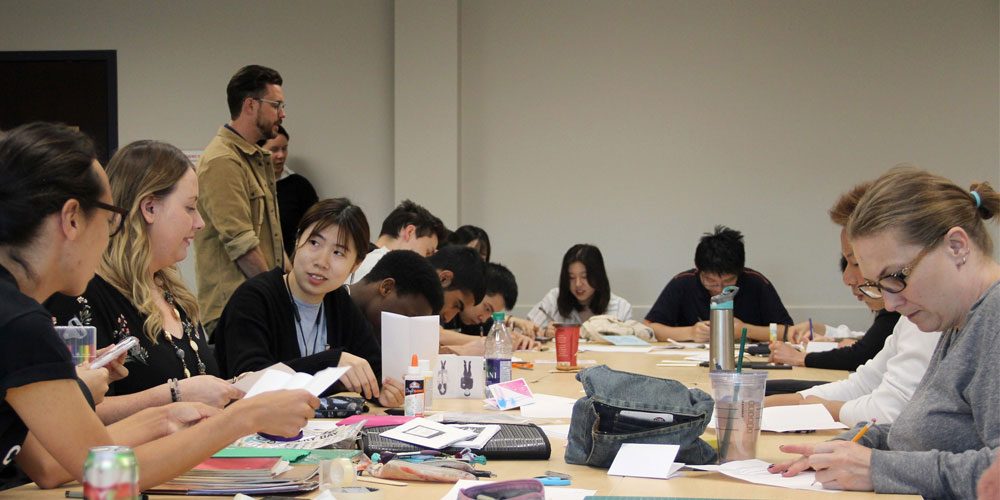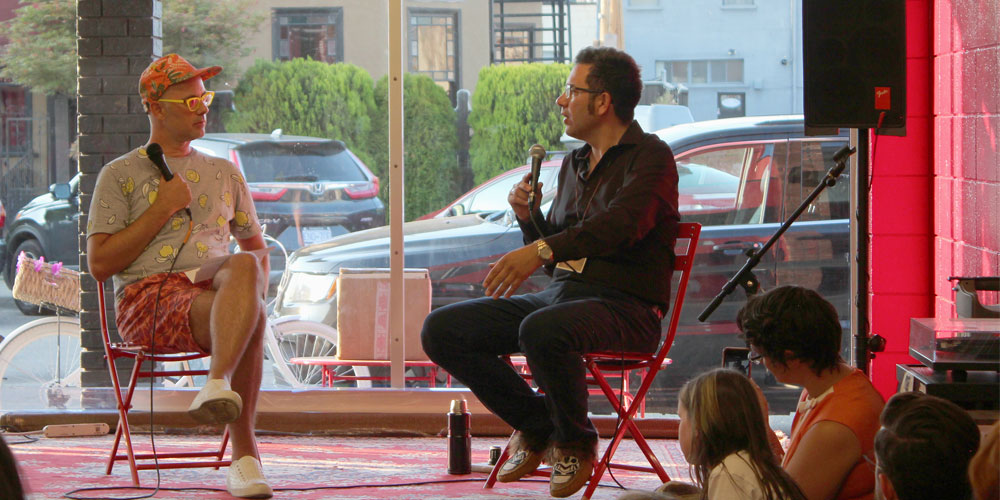Indigenous Art Intensive
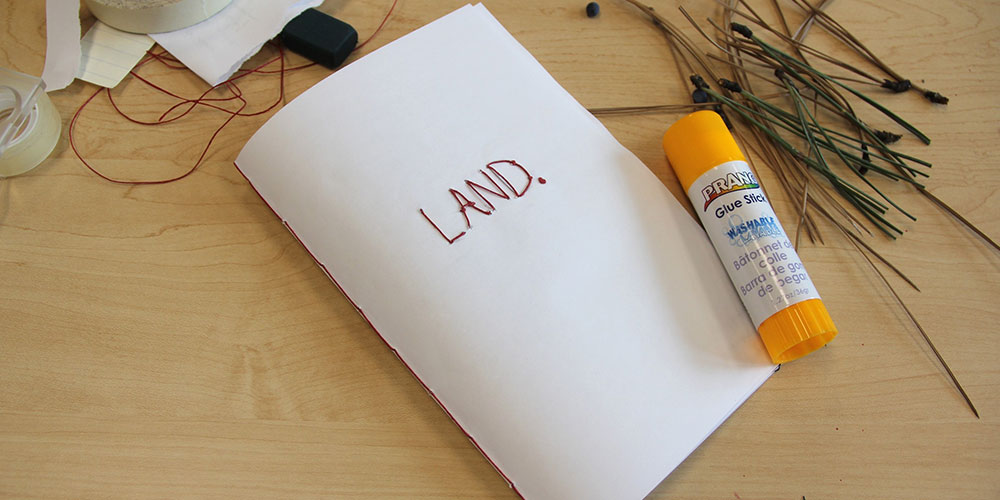
UBC Okanagan’s Indigenous Art Intensive offers an educational series of courses, lectures, art shows, and opportunities to create art. It features a series of world-renowned speakers, a variety of related undergraduate and graduate credit courses, and a group of resident artists who will be working to create a new body of work.
The Indigenous Art Intensive is on hiatus for summer 2026. UBC Okanagan Gallery will present an exhibition and programming in collaboration with the Morris and Helen Belkin Art Gallery at UBC Vancouver (not in association with the Indigenous Art Intensive). No classes will be offered in 2026. Programming for Fall 2026 will be shared when available.
Program
The Indigenous Art Intensive features a series of world-renowned speakers, a variety of related undergraduate and graduate credit courses, and a group of resident artists who will be working to create new works. The Intensive broadly engages the theme Site/ation, connecting to place through Indigenous territoriality, being grounded in land, voice and language, reconnecting to/nurturing traditions, and beyond.
From 2014 to 2025, the Intensive offered an immersive experience of undergraduate and graduate courses in Visual Arts, Creative Writing, Art History and Visual Culture, and Indigenous Studies, along with panel conversations, keynote addresses, art exhibitions and performances, readings, and various additional events and fieldtrips throughout – some planned, some impromptu.
The Indigenous Art Intensive is a unique program that brings international and national Indigenous scholars, curators and artists together on campus to interact with students in a residency context. Visiting artists participated in a series of keynote presentations and artist panels once a week throughout the program.
Past Visiting Artists
The curators and visiting artists for 2025 included Jamie Isaac, Serena Steel, Sherry Farrel Racette, Faye Heavyshield, Joseph Naytowhow, Marie-Anne Redhead, Peter Morin, Justine Woods, Nicole Neidhardt, Catherine Blackburn, Judy Anderson, and Les Louis.
The 2024 keynote speakers included Kevin McKenzie, Heather Igloliort and Daina Warren. They were joined by visiting artists Taylor Baptiste, Corrine Derickson, Mariel and Sienna Belanger, asinnajaq, Marika Swan, Krystle Silverfox, Nicole Neidhardt, Peter Morin, Michelle Sound, Victoria Jaenig, and Justine Woods.
 Dion Kaszas is an Nlaka’pamux cultural tattoo practitioner and a leader in the revival of Indigenous tattooing in Canada. He has been tattooing professionally since 2009 and started the revival of Nlaka’pamux tattooing in 2012. Dion travels to National and International events, conferences, and tattoo festivals representing Nlaka’pamux and Indigenous tattooing in Canada. He specialize in Blackwork with an emphasis on traditional hand tattooing techniques. These include hand poke and skin stitch tattooing methods which arise from his Nlaka’pamux culture. He has had the honor of assisting in the revival of Indigenous tattooing across Turtle Island (North America). Dion’s passion for tattooing extends beyond his artistic work into the successful completion of his Masters degree in Indigenous Studies at the University of British Columbia Okanagan. His continued area of research is Indigenous tattooing, focusing keenly on the revival of Indigenous peoples tattooing practices, using Indigenous and Creative research methodologies. Since his graduation Dion has contributed to a variety of publications and exhibitions as author, editor, curator and consultant. His work has been featured in Tattoo Traditions of Native North America: Ancient and Contemporary Expressions of Identity, The World Atlas of Tattoo, and highlighted in Newspaper articles from the New York Times to the CBC. In 2018, he was featured in a variety documentary films and TV series. These include Skindigenous, a 3 Season, 13-part documentary series produced in association with APTN exploring Indigenous tattooing traditions around the world and the FOX Nation series USA Ink.
Dion Kaszas is an Nlaka’pamux cultural tattoo practitioner and a leader in the revival of Indigenous tattooing in Canada. He has been tattooing professionally since 2009 and started the revival of Nlaka’pamux tattooing in 2012. Dion travels to National and International events, conferences, and tattoo festivals representing Nlaka’pamux and Indigenous tattooing in Canada. He specialize in Blackwork with an emphasis on traditional hand tattooing techniques. These include hand poke and skin stitch tattooing methods which arise from his Nlaka’pamux culture. He has had the honor of assisting in the revival of Indigenous tattooing across Turtle Island (North America). Dion’s passion for tattooing extends beyond his artistic work into the successful completion of his Masters degree in Indigenous Studies at the University of British Columbia Okanagan. His continued area of research is Indigenous tattooing, focusing keenly on the revival of Indigenous peoples tattooing practices, using Indigenous and Creative research methodologies. Since his graduation Dion has contributed to a variety of publications and exhibitions as author, editor, curator and consultant. His work has been featured in Tattoo Traditions of Native North America: Ancient and Contemporary Expressions of Identity, The World Atlas of Tattoo, and highlighted in Newspaper articles from the New York Times to the CBC. In 2018, he was featured in a variety documentary films and TV series. These include Skindigenous, a 3 Season, 13-part documentary series produced in association with APTN exploring Indigenous tattooing traditions around the world and the FOX Nation series USA Ink.
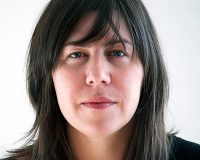 Nadia Myre is a renowned interdisciplinary artist and Algonquin member of the Kitigan Zibi Anishinabeg First Nation. As exemplified by seminal works such as Indian Act (2002), The Scar Project (2005-2013), and A Casual Reconstruction (2015), Myre explores the politics of belonging by positioning it within a framework of Indigenous resistance and resilience. Extensively exhibited and collected, Myre’s work can be found in the collections of the National Gallery of Canada, Smithsonian Institute National Museum of American Indian, Kadist Foundation, Musée nationale des beaux-arts du Québec, Art Gallery of Ontario, Montreal Art Contemporary, and Montreal Museum of Fine Arts. Myre is the recipient of numerous commissions and awards, notably the Louis-Comtois Prize (2021), Sobey Art Award (2014) for Canadian artists under 40, and in 2019 was inducted into the Order of Arts and Letters of Québec.
Nadia Myre is a renowned interdisciplinary artist and Algonquin member of the Kitigan Zibi Anishinabeg First Nation. As exemplified by seminal works such as Indian Act (2002), The Scar Project (2005-2013), and A Casual Reconstruction (2015), Myre explores the politics of belonging by positioning it within a framework of Indigenous resistance and resilience. Extensively exhibited and collected, Myre’s work can be found in the collections of the National Gallery of Canada, Smithsonian Institute National Museum of American Indian, Kadist Foundation, Musée nationale des beaux-arts du Québec, Art Gallery of Ontario, Montreal Art Contemporary, and Montreal Museum of Fine Arts. Myre is the recipient of numerous commissions and awards, notably the Louis-Comtois Prize (2021), Sobey Art Award (2014) for Canadian artists under 40, and in 2019 was inducted into the Order of Arts and Letters of Québec.
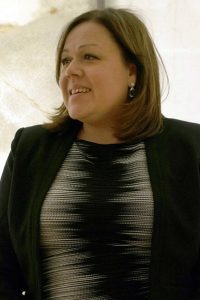 Audra Simpson is Professor of Anthropology at Columbia University and currently Distinguished Visiting Scholar at the University of Chicago. She researches and writes about Indigenous and settler society, politics and history. She is the author of Mohawk Interruptus: Political Life Across the Borders of Settler States (Duke University Press, 2014), winner of the Native American and Indigenous Studies Association’s Best First Book in Native American and Indigenous Studies Prize, the Laura Romero Prize from the American Studies Association, the Sharon Stephens Prize from the American Ethnological Society (2015) and CHOICE Outstanding Academic Title in 2014. She is co-editor of Theorizing Native Studies (Duke University Press, 2014). She has articles in South Atlantic Quarterly, Postcolonial Studies, Theory & Event, Cultural Anthropology, American Quarterly, Junctures, Law and Contemporary Problems, Wicazo Sa Review and Annual Reviews in Anthropology. She was a Distinguished Visiting Scholar at the Jackman Humanities Institute at the University of Toronto in 2018, the Nicholson Distinguished Visiting Scholar in the Unit for Criticism and Theory at University of Illinois (Urbana-Champaign) in 2019. In 2010 she won Columbia University’s School for General Studies Excellence in Teaching Award. In 2020 she won the Mark Van Doren Award for Teaching. She was the second anthropologist in the 50-year history of the award to do so. She is a Kahnawà:ke Mohawk.
Audra Simpson is Professor of Anthropology at Columbia University and currently Distinguished Visiting Scholar at the University of Chicago. She researches and writes about Indigenous and settler society, politics and history. She is the author of Mohawk Interruptus: Political Life Across the Borders of Settler States (Duke University Press, 2014), winner of the Native American and Indigenous Studies Association’s Best First Book in Native American and Indigenous Studies Prize, the Laura Romero Prize from the American Studies Association, the Sharon Stephens Prize from the American Ethnological Society (2015) and CHOICE Outstanding Academic Title in 2014. She is co-editor of Theorizing Native Studies (Duke University Press, 2014). She has articles in South Atlantic Quarterly, Postcolonial Studies, Theory & Event, Cultural Anthropology, American Quarterly, Junctures, Law and Contemporary Problems, Wicazo Sa Review and Annual Reviews in Anthropology. She was a Distinguished Visiting Scholar at the Jackman Humanities Institute at the University of Toronto in 2018, the Nicholson Distinguished Visiting Scholar in the Unit for Criticism and Theory at University of Illinois (Urbana-Champaign) in 2019. In 2010 she won Columbia University’s School for General Studies Excellence in Teaching Award. In 2020 she won the Mark Van Doren Award for Teaching. She was the second anthropologist in the 50-year history of the award to do so. She is a Kahnawà:ke Mohawk.
 Dylan Robinson is a xwélmexw (Stó:lō/Skwah) artist, curator and writer, as well as an Associate Professor in the School of Music at the University of British Columbia. He is the author of Hungry Listening: Resonant Theory for Indigenous Sound Studies (2020), a book that examines Indigenous and settler colonial practices of listening. With Candice Hopkins, he is also the curator of Soundings, an internationally touring exhibition with Independent Curators International, that features an ever-growing number of Indigenous art scores and performances. Robinson’s current research examines how public art interpellates the public as settler and Indigenous subjects.
Dylan Robinson is a xwélmexw (Stó:lō/Skwah) artist, curator and writer, as well as an Associate Professor in the School of Music at the University of British Columbia. He is the author of Hungry Listening: Resonant Theory for Indigenous Sound Studies (2020), a book that examines Indigenous and settler colonial practices of listening. With Candice Hopkins, he is also the curator of Soundings, an internationally touring exhibition with Independent Curators International, that features an ever-growing number of Indigenous art scores and performances. Robinson’s current research examines how public art interpellates the public as settler and Indigenous subjects.
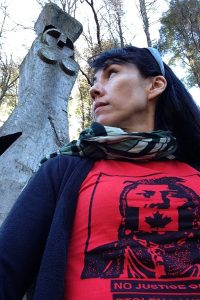 Mariel Belanger is a PhD student at Queens University in Cultural Studies researching ethnographic historical documents and recordings to map the archives for family specific song, story and lived experiences of the Syilx people at the Head of the Lake, Mariel’s research centre’s identity through the lens of Indigenous ways of knowing and being in the world, customary law, Indigenous feminism, smi7may7 Syilx performance theory, intersectionality, the effects of being ‘half’ and exploring how cultural identity is rebuilt through oral history and performance practice. Mariel’s MFA thesis “The Earth Re:Claimed Her. A continuing study of Blood Memory, Embodied Story Practice and Personal Governance” won her an SSHRC scholarship and was the foundation to bringing new histories to light. Mariel has travelled to Chile from Temuco to Socorama demonstrating a sqilxw-centric land-based visitor protocol and performing how colonial violence still affects the bodies of Indigenous women through her performance Illegal: Let Us Live co-authored by the late Dr. Greg Younging. In 2022 Mariel won a CGS SSHRC Doctoral Scholarship and the Teyonkwayenawá:kon – Queens University Graduate Scholarship. Mariel’s writing can be found in the chapter “Sqilxw Woman: She Brings Bundles” in the forthcoming book Unsettling Education: Decolonizing and Indigenizing the Land, “Respons(A)bility: Weaving Words of Responsibility Through Story” in the online journal Revue Percees, “stəqpistns iʔ pqlqin / kihew omīkwan Eagle Feather” in New Directions for Theorizing in Qualitative Inquiry, “Experiencing Resonance as a Practice of Ritual Engagement” co-authored chapter in Research and Reconciliation, and alt.Theatre Cultural Diversity and the Stage Magazine Vol 14.1 through 14.3 as guest curator and writer.
Mariel Belanger is a PhD student at Queens University in Cultural Studies researching ethnographic historical documents and recordings to map the archives for family specific song, story and lived experiences of the Syilx people at the Head of the Lake, Mariel’s research centre’s identity through the lens of Indigenous ways of knowing and being in the world, customary law, Indigenous feminism, smi7may7 Syilx performance theory, intersectionality, the effects of being ‘half’ and exploring how cultural identity is rebuilt through oral history and performance practice. Mariel’s MFA thesis “The Earth Re:Claimed Her. A continuing study of Blood Memory, Embodied Story Practice and Personal Governance” won her an SSHRC scholarship and was the foundation to bringing new histories to light. Mariel has travelled to Chile from Temuco to Socorama demonstrating a sqilxw-centric land-based visitor protocol and performing how colonial violence still affects the bodies of Indigenous women through her performance Illegal: Let Us Live co-authored by the late Dr. Greg Younging. In 2022 Mariel won a CGS SSHRC Doctoral Scholarship and the Teyonkwayenawá:kon – Queens University Graduate Scholarship. Mariel’s writing can be found in the chapter “Sqilxw Woman: She Brings Bundles” in the forthcoming book Unsettling Education: Decolonizing and Indigenizing the Land, “Respons(A)bility: Weaving Words of Responsibility Through Story” in the online journal Revue Percees, “stəqpistns iʔ pqlqin / kihew omīkwan Eagle Feather” in New Directions for Theorizing in Qualitative Inquiry, “Experiencing Resonance as a Practice of Ritual Engagement” co-authored chapter in Research and Reconciliation, and alt.Theatre Cultural Diversity and the Stage Magazine Vol 14.1 through 14.3 as guest curator and writer.
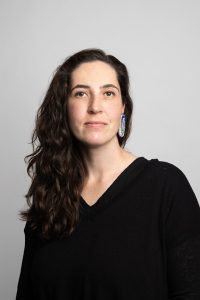 Tiffany Shaw is a Métis architect, artist and curator based in Alberta. She holds a BFA from Nova Scotia College of Art and Design (NSCAD) University, a Masters in Architecture from the Southern California Institute of Architecture (SCI-Arc) and is currently working at Reimagine Architects. Her practice is often guided by communal interventions as a way to engage a lifted understanding of place. While born in Calgary and raised in Edmonton, Shaw’s Métis lineage derives from Fort McMurray via Fort McKay and the Red River.
Tiffany Shaw is a Métis architect, artist and curator based in Alberta. She holds a BFA from Nova Scotia College of Art and Design (NSCAD) University, a Masters in Architecture from the Southern California Institute of Architecture (SCI-Arc) and is currently working at Reimagine Architects. Her practice is often guided by communal interventions as a way to engage a lifted understanding of place. While born in Calgary and raised in Edmonton, Shaw’s Métis lineage derives from Fort McMurray via Fort McKay and the Red River.
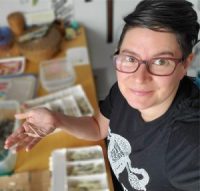 Vanessa Dion Fletcher is a Lenape and Potawatomi neurodiverse Artist; her family is from Eelūnaapèewii Lahkèewiitt (displaced from Lenapehoking) and European settlers. She uses porcupine quills, Wampum belts, and menstrual blood to reveal the complexities of what defines a body physically and culturally. Reflecting on an Indigenous and gendered body with a neurodiverse mind, Dion Fletcher primarily works in performance, textiles and video. She graduated from The School of the Art Institute of Chicago in 2016 with an MFA in performance and a Bachelor of Fine Arts from York University in 2009. She has exhibited across Canada and the USA at Art Mur Montreal, Eastern Edge Gallery Newfoundland, The Queer Arts Festival Vancouver and the Satellite Art show in Miami. Her work is in the Indigenous Art Centre, Joan Flasch Artist Book Collection, Vtape, Seneca College, Global Affairs Canada and the Archives of American Art.
Vanessa Dion Fletcher is a Lenape and Potawatomi neurodiverse Artist; her family is from Eelūnaapèewii Lahkèewiitt (displaced from Lenapehoking) and European settlers. She uses porcupine quills, Wampum belts, and menstrual blood to reveal the complexities of what defines a body physically and culturally. Reflecting on an Indigenous and gendered body with a neurodiverse mind, Dion Fletcher primarily works in performance, textiles and video. She graduated from The School of the Art Institute of Chicago in 2016 with an MFA in performance and a Bachelor of Fine Arts from York University in 2009. She has exhibited across Canada and the USA at Art Mur Montreal, Eastern Edge Gallery Newfoundland, The Queer Arts Festival Vancouver and the Satellite Art show in Miami. Her work is in the Indigenous Art Centre, Joan Flasch Artist Book Collection, Vtape, Seneca College, Global Affairs Canada and the Archives of American Art.
 Gabrielle L’Hirondelle Hill (b. 1979, Comox, British Columbia) is a Métis artist and writer. Hill’s sculptural practice explores the history of found materials to enquire into concepts of land, property, and economy. Often, her projects emerge from an interest in capitalism as an imposed, impermanent, and vulnerable system, as well as in alternative economic modes. Her works have used found and readily-sourced materials to address concepts such as private property, exchange, and black-market economies. Hill is a member of BUSH gallery, an Indigenous artist collective seeking to decentre Eurocentric models of making and thinking about art, prioritizing instead land-based teachings and Indigenous epistemologies. Hill received her MFA from the California College of the Arts, and a BFA and BA from Simon Fraser University. Most recently, her work has been exhibited at the 59th Venice Biennale, Venice (2022); Le Magasin CNAC, Grenoble, France (2022); Museum of Modern Art, New York, New York (2021); College Art Galleries at the University of Saskatchewan, Saskatoon (2020); Cooper Cole, Toronto (2019); Burnaby Art Gallery, Burnaby (2019); Unit 17, Vancouver (2018; 2019) Gallery TPW, Toronto (2018); Art Gallery of Alberta, Edmonton (2018); SBC galerie d’art contemporain, Montreal with the Woodland School (2017); and others. Hill has a forthcoming solo exhibition at the Contemporary Art Gallery, Vancouver. Her writing has been published in many places, including in Beginning With the Seventies (Helen Belkin, 2019). She is also the co-editor of The Land We Are: Artists and Writers Unsettle the Politics of Reconciliation (ARP 2009) and Read, Listen, Tell: Indigenous Stories from Turtle Island (Wilfred Laurier 2017). Hill lives on the unceded territories of the Sḵwx̱wú7mesh, Musqueam, and Tsleil-Waututh peoples.
Gabrielle L’Hirondelle Hill (b. 1979, Comox, British Columbia) is a Métis artist and writer. Hill’s sculptural practice explores the history of found materials to enquire into concepts of land, property, and economy. Often, her projects emerge from an interest in capitalism as an imposed, impermanent, and vulnerable system, as well as in alternative economic modes. Her works have used found and readily-sourced materials to address concepts such as private property, exchange, and black-market economies. Hill is a member of BUSH gallery, an Indigenous artist collective seeking to decentre Eurocentric models of making and thinking about art, prioritizing instead land-based teachings and Indigenous epistemologies. Hill received her MFA from the California College of the Arts, and a BFA and BA from Simon Fraser University. Most recently, her work has been exhibited at the 59th Venice Biennale, Venice (2022); Le Magasin CNAC, Grenoble, France (2022); Museum of Modern Art, New York, New York (2021); College Art Galleries at the University of Saskatchewan, Saskatoon (2020); Cooper Cole, Toronto (2019); Burnaby Art Gallery, Burnaby (2019); Unit 17, Vancouver (2018; 2019) Gallery TPW, Toronto (2018); Art Gallery of Alberta, Edmonton (2018); SBC galerie d’art contemporain, Montreal with the Woodland School (2017); and others. Hill has a forthcoming solo exhibition at the Contemporary Art Gallery, Vancouver. Her writing has been published in many places, including in Beginning With the Seventies (Helen Belkin, 2019). She is also the co-editor of The Land We Are: Artists and Writers Unsettle the Politics of Reconciliation (ARP 2009) and Read, Listen, Tell: Indigenous Stories from Turtle Island (Wilfred Laurier 2017). Hill lives on the unceded territories of the Sḵwx̱wú7mesh, Musqueam, and Tsleil-Waututh peoples.
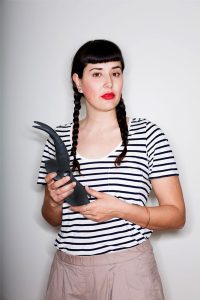 Tsēmā is an award-winning interdisciplinary artist, mentor, mentee and descendant of Tāłtān Matriarchy. Using strategies of care and resistance Tsēmā creates work that connects materials to mine sites and bodies to the land. This practice cites her Indigenous mentorships, Potlatch, studies in visual culture, and time in the mountains. She has studied at K’saan, Emily Carr University of Art and Design, and earned an Interdisciplinary Masters of Art Media and Design from OCADu. Tsēmā has exhibited and performed on Turtle Island, and beyond.
Tsēmā is an award-winning interdisciplinary artist, mentor, mentee and descendant of Tāłtān Matriarchy. Using strategies of care and resistance Tsēmā creates work that connects materials to mine sites and bodies to the land. This practice cites her Indigenous mentorships, Potlatch, studies in visual culture, and time in the mountains. She has studied at K’saan, Emily Carr University of Art and Design, and earned an Interdisciplinary Masters of Art Media and Design from OCADu. Tsēmā has exhibited and performed on Turtle Island, and beyond.
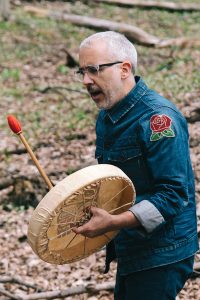 Peter Morin is a grandson of Tahltan Ancestor Artists. Morin’s artistic offerings can be organized around four themes: articulating Land/Knowing, articulating Indigenous Grief/Loss, articulating Community Knowing, and understanding the Creative Agency/Power of the Indigenous body. The work takes place in galleries, in community, in collaboration, and on the land. All of the work is informed by dreams, Ancestors, Family members, and performance art as a research methodology. Initially trained in lithography, Morin’s 20 years of artistic practice moves from printmaking to poetry to button blanket making to installation drum making to bead work to performance art. Throughout his 20 year exhibition and making history, Morin has focused upon his matrilineal inheritances in homage to the matriarchal structuring of the Tahltan Nation, and prioritizes Cross-Ancestral collaborations as a strategy for interrogating and dismantling the colonialism.
Peter Morin is a grandson of Tahltan Ancestor Artists. Morin’s artistic offerings can be organized around four themes: articulating Land/Knowing, articulating Indigenous Grief/Loss, articulating Community Knowing, and understanding the Creative Agency/Power of the Indigenous body. The work takes place in galleries, in community, in collaboration, and on the land. All of the work is informed by dreams, Ancestors, Family members, and performance art as a research methodology. Initially trained in lithography, Morin’s 20 years of artistic practice moves from printmaking to poetry to button blanket making to installation drum making to bead work to performance art. Throughout his 20 year exhibition and making history, Morin has focused upon his matrilineal inheritances in homage to the matriarchal structuring of the Tahltan Nation, and prioritizes Cross-Ancestral collaborations as a strategy for interrogating and dismantling the colonialism.
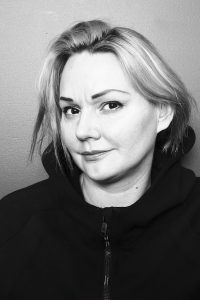 Krystle Silverfox is a member of Selkirk First Nation (Wolf Clan), and interdisciplinary visual artist. She currently lives and works on the territory of the Kwanlin Dün First Nation and Ta’an Kwach’an Council (Whitehorse, Yukon). Silverfox holds both a BFA in Visual Art (2015); a BA in Gender, Race, Sexuality and Social Justice from UBC (2013); also an MFA in Interdisciplinary studies from Simon Fraser University (2019). Her artistic practice explores different materials, methodologies, and symbols to create conceptual works. Krystle Silverfox is inspired by Indigenous feminism, trans- nationalism, decolonialism, activism, and lived experience.
Krystle Silverfox is a member of Selkirk First Nation (Wolf Clan), and interdisciplinary visual artist. She currently lives and works on the territory of the Kwanlin Dün First Nation and Ta’an Kwach’an Council (Whitehorse, Yukon). Silverfox holds both a BFA in Visual Art (2015); a BA in Gender, Race, Sexuality and Social Justice from UBC (2013); also an MFA in Interdisciplinary studies from Simon Fraser University (2019). Her artistic practice explores different materials, methodologies, and symbols to create conceptual works. Krystle Silverfox is inspired by Indigenous feminism, trans- nationalism, decolonialism, activism, and lived experience.
 Michelle Sound is a Cree and Métis artist, educator and mother. She is a member of Wapsewsipi Swan River First Nation in Northern Alberta. Her mother is Cree from Kinuso, Alberta, Treaty 8 territory and her father’s family is Métis from the Buffalo Lake Métis settlement in central Alberta. She was born and raised on the unceded and ancestral home territories of the xʷməθkwəy̓əm (Musqueam), Skwxwú7mesh (Squamish) and Səl̓ílwətaʔ/Selilwitulh (Tsleil-Waututh) Nations. She holds a Bachelor of Fine Arts from Simon Fraser University, School for the Contemporary Arts, and a Master of Applied Arts from Emily Carr University Art + Design. Michelle was a 2021 Salt Spring National Art Award Finalist and has had recent exhibitions at the Art Gallery of St. Albert, Neutral Ground ARC (Regina), Daphne Art Centre (Montréal), the Polygon Gallery and the grunt gallery(Vancouver). Her recent artist residency at Burrard Arts Foundation included her exhibition Aunties Holding It Together.
Michelle Sound is a Cree and Métis artist, educator and mother. She is a member of Wapsewsipi Swan River First Nation in Northern Alberta. Her mother is Cree from Kinuso, Alberta, Treaty 8 territory and her father’s family is Métis from the Buffalo Lake Métis settlement in central Alberta. She was born and raised on the unceded and ancestral home territories of the xʷməθkwəy̓əm (Musqueam), Skwxwú7mesh (Squamish) and Səl̓ílwətaʔ/Selilwitulh (Tsleil-Waututh) Nations. She holds a Bachelor of Fine Arts from Simon Fraser University, School for the Contemporary Arts, and a Master of Applied Arts from Emily Carr University Art + Design. Michelle was a 2021 Salt Spring National Art Award Finalist and has had recent exhibitions at the Art Gallery of St. Albert, Neutral Ground ARC (Regina), Daphne Art Centre (Montréal), the Polygon Gallery and the grunt gallery(Vancouver). Her recent artist residency at Burrard Arts Foundation included her exhibition Aunties Holding It Together.
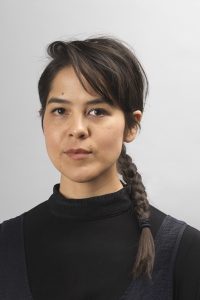 Krista Belle Stewart (b. 1979, Syilx Nation; lives in Berlin and Vienna) is a citizen of the Syilx Nation. She works primarily with video, photography, sculpture, and performance, drawing out personal and political narratives inherent in archival materials while questioning their articulation in institutional histories. She has had solo exhibitions at Goethe Institut, Seattle; Museum of Contemporary Art, Toronto; Nanaimo Art Gallery, BC; Künstlerhaus Bethanien, Berlin; Teck Gallery at Simon Fraser University, Vancouver; and Mercer Union as part of the 28th Images Festival, Toronto. Group exhibitions include Kunstverein, Hamburg; Eva International, Limerick; Bonniers Konsthall, Stockholm; CTM Festival, Berlin; International Studio & Curatorial Program, Brooklyn; Musée d’Art Contemporain, Montreal; and Vancouver Art Gallery. Screenings and performances include MoMA’s Doc Fortnight, New York; UnionDocs, Brooklyn; 221A, Vancouver; Plug-In Institute, Winnipeg; and Haus der Kulturen der Welt, Berlin. Her work is currently part of Galerie Barbara Thumm’s online platform New Viewings. She is an MFA graduate from the Milton Avery Graduate School of the Arts at Bard College and is presently a PhD in practice candidate at the Academy of Fine Arts, Vienna.
Krista Belle Stewart (b. 1979, Syilx Nation; lives in Berlin and Vienna) is a citizen of the Syilx Nation. She works primarily with video, photography, sculpture, and performance, drawing out personal and political narratives inherent in archival materials while questioning their articulation in institutional histories. She has had solo exhibitions at Goethe Institut, Seattle; Museum of Contemporary Art, Toronto; Nanaimo Art Gallery, BC; Künstlerhaus Bethanien, Berlin; Teck Gallery at Simon Fraser University, Vancouver; and Mercer Union as part of the 28th Images Festival, Toronto. Group exhibitions include Kunstverein, Hamburg; Eva International, Limerick; Bonniers Konsthall, Stockholm; CTM Festival, Berlin; International Studio & Curatorial Program, Brooklyn; Musée d’Art Contemporain, Montreal; and Vancouver Art Gallery. Screenings and performances include MoMA’s Doc Fortnight, New York; UnionDocs, Brooklyn; 221A, Vancouver; Plug-In Institute, Winnipeg; and Haus der Kulturen der Welt, Berlin. Her work is currently part of Galerie Barbara Thumm’s online platform New Viewings. She is an MFA graduate from the Milton Avery Graduate School of the Arts at Bard College and is presently a PhD in practice candidate at the Academy of Fine Arts, Vienna.
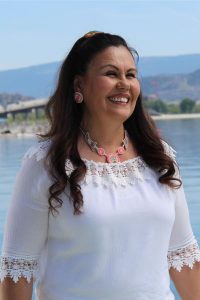 Tracey Kim Bonneau is member of the syilx Nation, born and raised in the unceded traditional territory of her ancestors the syilx -Okanagan. Tracey is a veteran writer and producer who has achieved recognition and awards from The Canadian Association of Broadcasters, American Indian Film Institute, BC Association of Broadcasters and BC Motion Picture Arts & Sciences Foundation of British Columbia (Leo Awards). Her most current works include her documentary series Quest OutWest Wild Food airing on the Aboriginal Peoples Television Network. As series creator Tracey produced, wrote and hosted 39 ½ hour episodes since 2014. Quest OutWest is scheduled for production, in the spring of 2022 for 13 more episodes. Tracey’s experience in print, radio, television and multimedia digital platforms spans over thirty years of freelance work and media arts project management. In 2018 Tracey joined the IM4 Lab, created by Loretta Todd. Tracey serves as a Matriarch with the IM4 lab in collaboration with Emily Carr University. The IM4 Lab offers free workshops to provide an accessible training forum for Indigenous peoples.IM4 is dedicated to Indigenizing VR/AR/360 by enabling Indigenous communities to find effective ways to incorporate these technologies into educational, cultural, language, artistic, commercial applications. Aside from her arts career Tracey is employed by a non-profit organization as the Manager of Arts Culture and Adult Higher Learning at En’owkin Centre located in Penticton.
Tracey Kim Bonneau is member of the syilx Nation, born and raised in the unceded traditional territory of her ancestors the syilx -Okanagan. Tracey is a veteran writer and producer who has achieved recognition and awards from The Canadian Association of Broadcasters, American Indian Film Institute, BC Association of Broadcasters and BC Motion Picture Arts & Sciences Foundation of British Columbia (Leo Awards). Her most current works include her documentary series Quest OutWest Wild Food airing on the Aboriginal Peoples Television Network. As series creator Tracey produced, wrote and hosted 39 ½ hour episodes since 2014. Quest OutWest is scheduled for production, in the spring of 2022 for 13 more episodes. Tracey’s experience in print, radio, television and multimedia digital platforms spans over thirty years of freelance work and media arts project management. In 2018 Tracey joined the IM4 Lab, created by Loretta Todd. Tracey serves as a Matriarch with the IM4 lab in collaboration with Emily Carr University. The IM4 Lab offers free workshops to provide an accessible training forum for Indigenous peoples.IM4 is dedicated to Indigenizing VR/AR/360 by enabling Indigenous communities to find effective ways to incorporate these technologies into educational, cultural, language, artistic, commercial applications. Aside from her arts career Tracey is employed by a non-profit organization as the Manager of Arts Culture and Adult Higher Learning at En’owkin Centre located in Penticton.
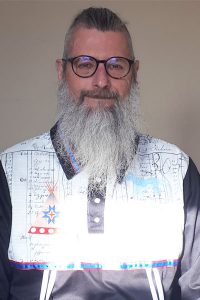 Steven Loft is Kanien’kehá:ka (also known as Mohawk), turtle clan of the Six Nations of the Grand River, also with Jewish heritage. He has recently been named the inaugural Vice President, Indigenous Ways and Decolonization at the National Gallery of Canada. Previous to this, he was the Director of Strategic Initiatives for Indigenous Arts and Culture and formerly Director of the Creating, Knowing and Sharing: The Arts and Cultures of First Nations, Inuit and Métis Peoples program with the Canada Council for the Arts. A curator, scholar, writer and media artist, in 2010 he was named Trudeau National Visiting Fellow at Ryerson University in Toronto. Loft has also held positions as Curator-In-Residence, Indigenous Art at the National Gallery of Canada, Director/Curator of the Urban Shaman Gallery (Winnipeg); Aboriginal Curator at the Art Gallery of Hamilton and Producer and Artistic Director of the Native Indian/Inuit Photographers’ Association (Hamilton). He has curated group and solo exhibitions across Canada and internationally; written extensively for magazines, catalogues and arts publications and lectured widely in Canada and internationally. Loft co-edited the books Transference, Technology, Tradition: Aboriginal Media and New Media Art (Banff Centre Press, 2005) and Coded Territories: Indigenous Pathways in New Media (University of Calgary Press, 2014).
Steven Loft is Kanien’kehá:ka (also known as Mohawk), turtle clan of the Six Nations of the Grand River, also with Jewish heritage. He has recently been named the inaugural Vice President, Indigenous Ways and Decolonization at the National Gallery of Canada. Previous to this, he was the Director of Strategic Initiatives for Indigenous Arts and Culture and formerly Director of the Creating, Knowing and Sharing: The Arts and Cultures of First Nations, Inuit and Métis Peoples program with the Canada Council for the Arts. A curator, scholar, writer and media artist, in 2010 he was named Trudeau National Visiting Fellow at Ryerson University in Toronto. Loft has also held positions as Curator-In-Residence, Indigenous Art at the National Gallery of Canada, Director/Curator of the Urban Shaman Gallery (Winnipeg); Aboriginal Curator at the Art Gallery of Hamilton and Producer and Artistic Director of the Native Indian/Inuit Photographers’ Association (Hamilton). He has curated group and solo exhibitions across Canada and internationally; written extensively for magazines, catalogues and arts publications and lectured widely in Canada and internationally. Loft co-edited the books Transference, Technology, Tradition: Aboriginal Media and New Media Art (Banff Centre Press, 2005) and Coded Territories: Indigenous Pathways in New Media (University of Calgary Press, 2014).
 Cheryl L’Hirondelle (Cree/Halfbreed; German/Polish) is an interdisciplinary artist, singer/songwriter and new media curator whose family roots are from Treaty Six: Papaschase First Nation / amiskwaciy wāskahikan (Edmonton) and Kikino Metis Settlement, AB. Her work investigates and articulates a dynamism of nēhiyawin (Cree worldview) in contemporary time-place incorporating Indigenous language(s), music, audio, video, VR, sewn objects, the olfactory, and audience/user participation to create immersive environments towards ‘radical inclusion’ and decolonisation. As a songwriter, L’Hirondelle’s focus is on both sharing nēhiyawēwin (Cree language) and Indigenous and contemporary song-forms and personal narrative songwriting as methodologies toward survivance. Cheryl was part of the historic Minquon Panchayat – a group of Indigenous and artists of colour who radically challenged and changed the artist-run movement in the early 90’s. Since 2008, she has been co-writing songs with incarcerated women, men and detained youth in federal prisons, provincial correctional centres and municipal detention centres. Cheryl was awarded two imagineNATIVE New Media Awards (2005 & 2006), and two Canadian Aboriginal Music Awards (2006 & 2007 as part of M’Girl) and is a recipient the 2021 Governor General’s Award in Visual and Media Art. She also exhibits, performs and presents nationally and internationally and she is currently a PhD candidate with SMARTlab at University College, Dublin, in Ireland.
Cheryl L’Hirondelle (Cree/Halfbreed; German/Polish) is an interdisciplinary artist, singer/songwriter and new media curator whose family roots are from Treaty Six: Papaschase First Nation / amiskwaciy wāskahikan (Edmonton) and Kikino Metis Settlement, AB. Her work investigates and articulates a dynamism of nēhiyawin (Cree worldview) in contemporary time-place incorporating Indigenous language(s), music, audio, video, VR, sewn objects, the olfactory, and audience/user participation to create immersive environments towards ‘radical inclusion’ and decolonisation. As a songwriter, L’Hirondelle’s focus is on both sharing nēhiyawēwin (Cree language) and Indigenous and contemporary song-forms and personal narrative songwriting as methodologies toward survivance. Cheryl was part of the historic Minquon Panchayat – a group of Indigenous and artists of colour who radically challenged and changed the artist-run movement in the early 90’s. Since 2008, she has been co-writing songs with incarcerated women, men and detained youth in federal prisons, provincial correctional centres and municipal detention centres. Cheryl was awarded two imagineNATIVE New Media Awards (2005 & 2006), and two Canadian Aboriginal Music Awards (2006 & 2007 as part of M’Girl) and is a recipient the 2021 Governor General’s Award in Visual and Media Art. She also exhibits, performs and presents nationally and internationally and she is currently a PhD candidate with SMARTlab at University College, Dublin, in Ireland.
 Michelle LaVallee is Anishinaabe (Ojibway) and a member of the Neyashiingamiing Chippewas of Nawash Unceded First Nation in Cape Croker, Ontario, and has Canadian Settler heritage of English/Scottish/French descent from her mother. She currently holds the position of Director of Indigenous Ways and Decolonization at the National Gallery of Canada. Previously she was Director of the Indigenous Art Centre at Crown-Indigenous Relations and Northern Affairs Canada (Gatineau, QC), where she was responsible for the development, care, and management of Canada’s oldest and only federal heritage collection devoted to Indigenous art. She worked as part of the Corporate Secretariat management team and led the Art Centre team towards better stabilization with regards to human resources, budget, acquisitions, and collection maintenance. LaVallee was Curator at the MacKenzie Art Gallery in Regina, Saskatchewan (2007–2017), and has curated exhibitions for galleries including A Space Gallery (Toronto) and Gallery 101 (Ottawa). Her curatorial work has explored the colonial relations that have shaped historical and contemporary culture through exhibitions including: Moving Forward, Never Forgetting (2015); 13 Coyotes: Edward Poitras (2012); Blow Your House In: Vernon Ah Kee (2009); and Miss Chief: Shadow Catcher—Kent Monkman (2008). LaVallee organized the historical and nationally touring exhibition 7: Professional Native Indian Artists Inc. (2013–2016) and award-winning book contextualizing their influential role in contemporary Canadian art history. She has been a chosen participant for a number of Canadian Indigenous Curators Delegations sent to Australia, New Zealand and Venice, and her curatorial work has been recognized by three Saskatchewan Book Awards, and the City of Regina Mayor’s Arts and Business Awards.
Michelle LaVallee is Anishinaabe (Ojibway) and a member of the Neyashiingamiing Chippewas of Nawash Unceded First Nation in Cape Croker, Ontario, and has Canadian Settler heritage of English/Scottish/French descent from her mother. She currently holds the position of Director of Indigenous Ways and Decolonization at the National Gallery of Canada. Previously she was Director of the Indigenous Art Centre at Crown-Indigenous Relations and Northern Affairs Canada (Gatineau, QC), where she was responsible for the development, care, and management of Canada’s oldest and only federal heritage collection devoted to Indigenous art. She worked as part of the Corporate Secretariat management team and led the Art Centre team towards better stabilization with regards to human resources, budget, acquisitions, and collection maintenance. LaVallee was Curator at the MacKenzie Art Gallery in Regina, Saskatchewan (2007–2017), and has curated exhibitions for galleries including A Space Gallery (Toronto) and Gallery 101 (Ottawa). Her curatorial work has explored the colonial relations that have shaped historical and contemporary culture through exhibitions including: Moving Forward, Never Forgetting (2015); 13 Coyotes: Edward Poitras (2012); Blow Your House In: Vernon Ah Kee (2009); and Miss Chief: Shadow Catcher—Kent Monkman (2008). LaVallee organized the historical and nationally touring exhibition 7: Professional Native Indian Artists Inc. (2013–2016) and award-winning book contextualizing their influential role in contemporary Canadian art history. She has been a chosen participant for a number of Canadian Indigenous Curators Delegations sent to Australia, New Zealand and Venice, and her curatorial work has been recognized by three Saskatchewan Book Awards, and the City of Regina Mayor’s Arts and Business Awards.
 Kablusiak is a renowned multidisciplinary Inuvialuk artist and curator who uses Inuk ingenuity to create work in a variety of mediums including, but not limited to, lingerie, white flour, soapstone, permanent marker, bed sheets, felt, acrylic paint, and words. Their work explores the dis/connections between existence in Inuit diaspora while maintaining family and community ties, the impacts of colonization on Inuit gender and sexuality expressions, as well as on health and wellbeing, and the everyday. Kablusiak holds a BFA in Drawing from the Alberta University of the Arts in Mohkinstsis, where they are currently based. In 2021, Kablusiak was part of a team of 4 Inuit curators who curated the inaugural exhibition for Qaumajuq, entitled INUA. In all of their creative work Kablusiak seeks to demystify Inuit art and create the space for Inuit-led representation of the diverse aspects of Inuit cultures. Kablusiak’s work can be found in the collections of the Indigenous Art Centre, the Alberta Foundation for the Arts, the Art Gallery of Alberta, Banff Centre for Arts & Creativity and Global Affairs Visual Art Collection among others.
Kablusiak is a renowned multidisciplinary Inuvialuk artist and curator who uses Inuk ingenuity to create work in a variety of mediums including, but not limited to, lingerie, white flour, soapstone, permanent marker, bed sheets, felt, acrylic paint, and words. Their work explores the dis/connections between existence in Inuit diaspora while maintaining family and community ties, the impacts of colonization on Inuit gender and sexuality expressions, as well as on health and wellbeing, and the everyday. Kablusiak holds a BFA in Drawing from the Alberta University of the Arts in Mohkinstsis, where they are currently based. In 2021, Kablusiak was part of a team of 4 Inuit curators who curated the inaugural exhibition for Qaumajuq, entitled INUA. In all of their creative work Kablusiak seeks to demystify Inuit art and create the space for Inuit-led representation of the diverse aspects of Inuit cultures. Kablusiak’s work can be found in the collections of the Indigenous Art Centre, the Alberta Foundation for the Arts, the Art Gallery of Alberta, Banff Centre for Arts & Creativity and Global Affairs Visual Art Collection among others.
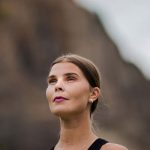 Meagan Musseau is L’nu (Mi’kmaw) from Elmastukwek, Ktaqmkuk territory (Bay of Islands, western Newfoundland). She nourishes an interdisciplinary arts practice by working with customary art forms and new media, such as basketry, beadwork, land-based performance, video and installation. She focuses on creating artwork, dancing, learning Mi’kmawlanguage, and facilitating workshops as a way to actively participate in survivance. Meagan is the recipient of numerous awards including the Sobey Art Award, longlist (2021); the Atlantic Canadian Emerging Artist, Hnatyshyn Foundation (2018); Emerging Artist Award, VANL-CARFAC (2018); Aboriginal Arts Development Award, First Peoples’ Cultural Council (2016). Her work exhibits nationally and internationally.
Meagan Musseau is L’nu (Mi’kmaw) from Elmastukwek, Ktaqmkuk territory (Bay of Islands, western Newfoundland). She nourishes an interdisciplinary arts practice by working with customary art forms and new media, such as basketry, beadwork, land-based performance, video and installation. She focuses on creating artwork, dancing, learning Mi’kmawlanguage, and facilitating workshops as a way to actively participate in survivance. Meagan is the recipient of numerous awards including the Sobey Art Award, longlist (2021); the Atlantic Canadian Emerging Artist, Hnatyshyn Foundation (2018); Emerging Artist Award, VANL-CARFAC (2018); Aboriginal Arts Development Award, First Peoples’ Cultural Council (2016). Her work exhibits nationally and internationally.
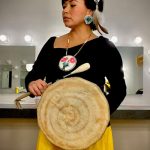 Csetkwe (she/her) is a multi-gifted artist with her roots in the Syilx (Okanagan) and Secwepmec (Shuswap) Nations. Holding the respect of being a sqwuy (mother to a son) stamiya (Two Spirit) and a Traditional Knowledge Keeper, she mainly works in performance art, song/ poetry writing, painting and illustration. She is a graduate of the En’owkin Centre of Indigenous Art, receiving a National Aboriginal Professional Artists’ Training certificate and Nsyilxcn Language Program certificate. She honed her love for performance art during her time in the Full Circle Ensemble Program in Vancouver, BC. Csetkwe’s performances include those of a Singer/ Song Carrier, Spoken Word Poet as part of the k̓ ʷem k̓ ʷem słénsłénəy – Indigenous Female Drum Collective and as the former front woman in multimedia performance collective Skookum Sound System. As a visual artist, Csetkwe is grateful to contribute to the Kama Collective and Ullus Collective.
Csetkwe (she/her) is a multi-gifted artist with her roots in the Syilx (Okanagan) and Secwepmec (Shuswap) Nations. Holding the respect of being a sqwuy (mother to a son) stamiya (Two Spirit) and a Traditional Knowledge Keeper, she mainly works in performance art, song/ poetry writing, painting and illustration. She is a graduate of the En’owkin Centre of Indigenous Art, receiving a National Aboriginal Professional Artists’ Training certificate and Nsyilxcn Language Program certificate. She honed her love for performance art during her time in the Full Circle Ensemble Program in Vancouver, BC. Csetkwe’s performances include those of a Singer/ Song Carrier, Spoken Word Poet as part of the k̓ ʷem k̓ ʷem słénsłénəy – Indigenous Female Drum Collective and as the former front woman in multimedia performance collective Skookum Sound System. As a visual artist, Csetkwe is grateful to contribute to the Kama Collective and Ullus Collective.
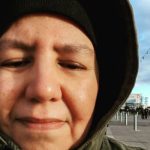 Charlene Vickers is a Vancouver based Anishinabe artist from Kenora, Ontario.. Her painting, sculpture and performance works explore memory, healing and embodied connections to ancestral lands. She is the recipient of the 2018 VIVA Award. Vickers graduated from Emily Carr University of Art and Design (94), Simon Fraser University in Critical Studies of the Arts (98), MFA (2013). Vickers has an extensive national and international exhibition history including recent solo exhibitions Big Blue Smudge at the University of Saskatchewan (2022), Ancestor Gesture: Diviners at NADA project space, NYC, (2022), Contemporary Art Gallery in Vancouver (September 2021), a duo solo summer exhibition along side artist Lawrence Paul Yuxweluptun Lets’lo:tseltun at Macaulay & Co. Fine Art (2021), Rain Shadow at the Nanaimo Art Gallery (2021), Where Do We Go From Here? at the Vancouver Art Gallery( 2020), the Biennale national de sculpture Contemporaine 2020 in Quebec, Where We Gather at Macaulay & Co. Fine Art(2020).
Charlene Vickers is a Vancouver based Anishinabe artist from Kenora, Ontario.. Her painting, sculpture and performance works explore memory, healing and embodied connections to ancestral lands. She is the recipient of the 2018 VIVA Award. Vickers graduated from Emily Carr University of Art and Design (94), Simon Fraser University in Critical Studies of the Arts (98), MFA (2013). Vickers has an extensive national and international exhibition history including recent solo exhibitions Big Blue Smudge at the University of Saskatchewan (2022), Ancestor Gesture: Diviners at NADA project space, NYC, (2022), Contemporary Art Gallery in Vancouver (September 2021), a duo solo summer exhibition along side artist Lawrence Paul Yuxweluptun Lets’lo:tseltun at Macaulay & Co. Fine Art (2021), Rain Shadow at the Nanaimo Art Gallery (2021), Where Do We Go From Here? at the Vancouver Art Gallery( 2020), the Biennale national de sculpture Contemporaine 2020 in Quebec, Where We Gather at Macaulay & Co. Fine Art(2020).
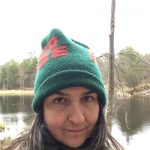 Lisa Myers is an Associate Professor in the Faculty of Environmental and Urban Change and holds a York Research Chair in Indigenous Art and Curatorial Practice. As a curator and artist with a keen interest in interdisciplinary collaboration, her research focuses on Contemporary Indigenous art considering the varied values and functions of elements such as medicine plants and language, sound, and materials. Through many media and materials including socially engaged art approaches, her art practice examines place, underrepresented histories/present/futures, and collective forms of knowledge exchange. Part of her curatorial practice includes artist advocacy. She is a co-chair of CARFAC Ontario and is passionate at navigating institutional barriers and limitations. Myers is a member of Beausoleil First Nation and is based in both Toronto and Port Severn, ON.
Lisa Myers is an Associate Professor in the Faculty of Environmental and Urban Change and holds a York Research Chair in Indigenous Art and Curatorial Practice. As a curator and artist with a keen interest in interdisciplinary collaboration, her research focuses on Contemporary Indigenous art considering the varied values and functions of elements such as medicine plants and language, sound, and materials. Through many media and materials including socially engaged art approaches, her art practice examines place, underrepresented histories/present/futures, and collective forms of knowledge exchange. Part of her curatorial practice includes artist advocacy. She is a co-chair of CARFAC Ontario and is passionate at navigating institutional barriers and limitations. Myers is a member of Beausoleil First Nation and is based in both Toronto and Port Severn, ON.
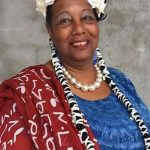 Carola Jones is a knowledge keeper of historical traditional textile practices of Algonquin Southeastern Woodlands people of color. Academically trained studio artist, art historian and teaching artist in K-12, community college and university settings including online instruction. A multi-generational natural dye practitioner, garment maker, and quilter. As a founding member of the international Seed To Runway Project, she teaches people to grow and harvest local plants and flowers for color and medicine as a way of self-healing by reconnecting with ancestral land and developing entrepreneurial skills. She is a studio artist, Pow Wow dancer, working traveler, writer, bundle binder, and storyteller who lives on the Coastal Plains of Eastern North Carolina. Carola’s blood ties represent many historical townships of the First Contact Tuscarora Confederacy, and her ancestors are connected with culturally significant events on the Outer Banks, Pamlico Sound, Fort Neyuher:uke, Contentnea Creek, Neuse River Basin, and Indian Woods.
Carola Jones is a knowledge keeper of historical traditional textile practices of Algonquin Southeastern Woodlands people of color. Academically trained studio artist, art historian and teaching artist in K-12, community college and university settings including online instruction. A multi-generational natural dye practitioner, garment maker, and quilter. As a founding member of the international Seed To Runway Project, she teaches people to grow and harvest local plants and flowers for color and medicine as a way of self-healing by reconnecting with ancestral land and developing entrepreneurial skills. She is a studio artist, Pow Wow dancer, working traveler, writer, bundle binder, and storyteller who lives on the Coastal Plains of Eastern North Carolina. Carola’s blood ties represent many historical townships of the First Contact Tuscarora Confederacy, and her ancestors are connected with culturally significant events on the Outer Banks, Pamlico Sound, Fort Neyuher:uke, Contentnea Creek, Neuse River Basin, and Indian Woods.
 Manuel Axel Strain is a 2Spirit artist from the lands and waters of the xʷməθkʷəyəm (Musqueam), Simpcw and Syilx peoples, based in the sacred homelands of their q̓ic̓əy̓(Katzie) and qʼʷa:n̓ƛʼən̓ (Kwantlen) relatives. Strains parents are Tracey Strain and Eric Strain, Strain’s grandparents are Harold Eustache (Chu Chua), Marie Louis (nk̓maplqs), Helen Point (xʷməθkʷəy̓əm) and John Strain (irish). Strains Great Grandparents Are Tina Cole (Sḵwx̱wú7mesh) and Tony Point (xʷməθkʷəy̓əm), Rose and Ben Louis (nk̓maplqs) and Manuel and Christine Eustache (Chu Chua). Although they attended Emily Carr University of Art + Design they prioritize Indigenous epistemologies through the embodied knowledge of their mother, father, siblings, cousins, aunties, uncles, nieces, nephews, grandparents and ancestors.
Manuel Axel Strain is a 2Spirit artist from the lands and waters of the xʷməθkʷəyəm (Musqueam), Simpcw and Syilx peoples, based in the sacred homelands of their q̓ic̓əy̓(Katzie) and qʼʷa:n̓ƛʼən̓ (Kwantlen) relatives. Strains parents are Tracey Strain and Eric Strain, Strain’s grandparents are Harold Eustache (Chu Chua), Marie Louis (nk̓maplqs), Helen Point (xʷməθkʷəy̓əm) and John Strain (irish). Strains Great Grandparents Are Tina Cole (Sḵwx̱wú7mesh) and Tony Point (xʷməθkʷəy̓əm), Rose and Ben Louis (nk̓maplqs) and Manuel and Christine Eustache (Chu Chua). Although they attended Emily Carr University of Art + Design they prioritize Indigenous epistemologies through the embodied knowledge of their mother, father, siblings, cousins, aunties, uncles, nieces, nephews, grandparents and ancestors.
Creating artwork in collaboration with and reference to their relatives, their shared experiences become a source of agency that resonates through their work with performance, land, painting, sculpture, photography, video, sound and installation. Their artworks often envelop subjects in relation with ancestral and community ties, Indigeneity, labour, resource extraction, gender, Indigenous medicines and life forces. Strain often perceives their work to confront and undermine the imposed realities of colonialism. Proposing a new space beyond its oppressive systems of power. They have contributed work to the Capture Photography Festival through Richmond Art Gallery, the Vancouver Art Gallery, Surrey Art Gallery, and more distant places across Turtle Island. UBC Okanagan gallery artist in residence programming TBC.
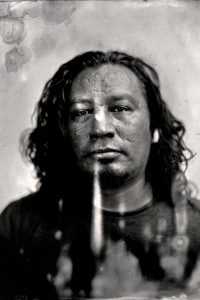 Terrance Houle (Niitsitapi/ Saulteaux) is an internationally recognized interdisciplinary media artist and a member of the Kainai Nation/ Blood Tribe. Involved with Aboriginal communities all his life, he has travelled to reservations throughout North America participating in Powwow dancing along with his native ceremonies.His work ranges from subversive to humorous absurdity to solemn and poetic artistic expressions. His work often relates to the physical body as it investigates issues of history, colonization, Aboriginal identity and representation in popular culture, as well as conceptual ideas based on memory, home, and reserve communities. Houle works in whatever media strikes him, and has produced work in photography, painting, installation, mass marketing, performance, music, video, and film. Houle’s work has been exhibited across Canada, the United States, Australia, the UK and Europe. Since 2014, Houle has been working on an ongoing collaborative project titled GHOST DAYS. GHOST DAYS evokes colonial and non-colonial histories that exist in the light of night as in the darkness of the day, and awakens a collaboration with artists, audience, and spirit. Currently, He has co-directed a short animation Otanimm/Onnimm with his daughter Neko Wong-Houle which is currently touring Film festivals, In Los Angeles, NYC, Toronto, New Zealand, Vancouver, Oxford & many more. Recently their short film won the prestigious Golden Sheaf Indigenous Award at Yorkton Film Festival and is Neko’s First Award in Film at 17 years old. Houle is based in Calgary, Alberta.
Terrance Houle (Niitsitapi/ Saulteaux) is an internationally recognized interdisciplinary media artist and a member of the Kainai Nation/ Blood Tribe. Involved with Aboriginal communities all his life, he has travelled to reservations throughout North America participating in Powwow dancing along with his native ceremonies.His work ranges from subversive to humorous absurdity to solemn and poetic artistic expressions. His work often relates to the physical body as it investigates issues of history, colonization, Aboriginal identity and representation in popular culture, as well as conceptual ideas based on memory, home, and reserve communities. Houle works in whatever media strikes him, and has produced work in photography, painting, installation, mass marketing, performance, music, video, and film. Houle’s work has been exhibited across Canada, the United States, Australia, the UK and Europe. Since 2014, Houle has been working on an ongoing collaborative project titled GHOST DAYS. GHOST DAYS evokes colonial and non-colonial histories that exist in the light of night as in the darkness of the day, and awakens a collaboration with artists, audience, and spirit. Currently, He has co-directed a short animation Otanimm/Onnimm with his daughter Neko Wong-Houle which is currently touring Film festivals, In Los Angeles, NYC, Toronto, New Zealand, Vancouver, Oxford & many more. Recently their short film won the prestigious Golden Sheaf Indigenous Award at Yorkton Film Festival and is Neko’s First Award in Film at 17 years old. Houle is based in Calgary, Alberta.
Kite is an Oglala Lakota performance artist, visual artist, and composer, a PhD candidate at Concordia University, Research Assistant for the Initiative for Indigenous Futures, a 2019 Trudeau Scholar, a 2020 Tulsa Artist Fellow, and a 2020 Women at Sundance x Adobe Fellow. Her research is concerned with contemporary Lakota ontologies through research-creation, computational media, and performance practice.
Camille Georgeson-Usher is a Coast Salish / Sahtu Dene / Scottish scholar, artist, and writer from Galiano Island, British Columbia which is the land of the Penelakut Nation. Usher completed her MA in Art History at Concordia University and is currently a PhD candidate at Queen’s University. In addition to her academic work, she is the Executive Director of the Indigenous Curatorial Collective and has worked as an arts programmer in a variety of arts institutions in both Quebec and Ontario. She has artwork currently exhibited in Soundings: An Exhibition in Five Parts; is on the curatorial team for MOMENTA 2021; sits on the boards of Artspace in Peterborough and the Toronto Biennial of Art; and finally, is a teaching fellow at Queen’s University.
Christine Howard Sandoval is an interdisciplinary artist of Obispeño Chumash and Hispanic ancestry. Her work challenges the boundaries of representation, access, and habitation through the use of performance, video, and sculpture. Howard Sandoval makes work about contested places, such as the historic Native and Hispanic waterways of northern New Mexico; the Gowanus Canal, a Superfund site in New York; and an interfacing suburban-wildland in Colorado.
Inuvialuk artist Maureen Gruben employs intimate materiality as she disassembles and re-combines disparate organic and industrial elements. Polar bear fur, beluga intestines, and seal skins encounter resins, vinyl, and bubble wrap, forging critical links between life in the Western Arctic and global environmental and cultural concerns. Gruben holds a BFA from the University of Victoria. She has exhibited regularly across Canada and internationally and her work is held in national and private collections. Born and raised in Tuktoyaktuk, she has a tacit knowledge of Arctic land and the rich but increasingly precarious resources it offers for both survival and creation.
Scott Benesiinaabandan is an Anishinaabe( Obishikokaang First Nations) intermedia artist that currently works in experimental image-making and sonic materials. Scott’s current research interests are intersections of artificial intelligence and Anishinaabemowin, Scott has completed international residencies at Parramatta Artist Studios in Australia, Context Gallery in Derry, North of Ireland, and University Lethbridge/Royal Institute of Technology iAIR. Scott has completed residencies with Initiative for Indigenous Futures and AbTec in Montreal. Benesiinaabandan has completed an MFA in photography at Concordia University and is currently working out of his hometown of Winnipeg where he is an artist-in-residence at Abijijiwan New Media Lab (2021).
Madeline Terbasket (they/them) is a two-spirit Syilx, Ho-Chunk, Anishinaabe performing artist that explores themes of cultural identity and mental health in their work. Madeline began making films as a teenager in their home territory of the Similkameen Valley in the South Okanagan. They attended six summer sessions at the Gulf Island Film and Television School. Madeline was in the Acting for Stage and Screen program at Capilano University. They discovered a passion for clowning and stand-up. They express their comedy by telling traditional Okanagan coyote stories. In 2017, Madeline was in šxʷʔam̓ət (home) with Theatre for Living, directed by David Diamond. In 2018, they toured BC and Alberta with the production. In 2019, Madeline was awarded a STORYHIVE Indigenous Storyteller Edition grant to make their film “q’sapi times”. They were also selected to be a TEDx speaker at Kelowna’s TEDxYouth @ DoyleAve. Madeline Terbasket is reimagining traditional stories with their physical comedy and vulnerability.
Peter Morin is a grandson of Tahltan ancestor artists. He has now lived away from his home territory for most of his life, but like his ancestors who have walked on the land, he carries Tahltan knowledge, ideas and history with him wherever he is. Every step along the way, Tahltan knowledge has guided his researching, dreaming, learning, making of the past twenty years of artistic and curatorial practice. Morin began art school in 1997, completing his Bachelor of Fine Arts at Emily Carr Institute of Art and Design in Vancouver in 2001 and his Masters in Fine Arts in 2010 at the University of British Columbia-Okanagan. Initially trained in lithography, Morin’s artistic practice moves from printmaking to poetry to drum making to button blanket making to installation to beadwork to performance art.
Jordan Abel is a Nisga’a writer from Vancouver. He is the author of The Place of Scraps (winner of the Dorothy Livesay Poetry Prize), Un/inhabited, and Injun (winner of the Griffin Poetry Prize).
Siku Allooloo is an Inuk/Haitian Taino writer, artist, and land-based educator from Denendeh (NWT) and Pond Inlet, NU. She also belongs to a Dené Sųłine family and a strong lineage of storytellers/leaders on all three sides who have raised her to be close to the land.
Mariel Belanger , MFA alumna from UBCO, is dedicated to contributing in the growth of interdisciplinary performance arts as a method to engage Indigenous community, language, culture and act as a bridge to society telling stories of our time.
Lacie Burning is a Kanien’kehá:ka (Mohawk) multi-disciplinary artist and curator raised on Six Nations of the Grand River located in Southern Ontario. They work in photography, video, installation, and sculpture.
RYAN! Elizabeth Feddersen b.1984 Confederated Tribes of the Colville (Okanogan /Arrow Lakes /German /English) is a mixed-media installation artist who specializes in interactive and immersive artworks that invite audience engagement.
Whess Harman (they/them pronouns) is mixed race, trans/non-binary queer/2SQ artist from the Carrier Wit’at Nation. Their on-going work includes beadwork and DIY strategies around punk aesthetics creating the “Potlatch Punk” series.
Eli Hirtle is a nêhiyaw(Cree)/British/German filmmaker, beadworker, and curator born and raised on Lekwungen territory (Victoria, BC). His practice involves documenting and creating work about Indigenous cultural resurgence, language revitalization, and identity.
Candice Hopkins is a writer, a curator and a citizen of Carcross/Tagish First Nation. Her practice explores the intersections of history, contemporary art and indigeneity.
Jaimie Isaac is a Winnipeg-based curator and interdisciplinary artist, member of Sagkeeng First Nation in Treaty 1 territory of Anishinaabe and British heritage. Her research focus is on Indigenous Curatorial Praxis, and methodologies in decolonizing and Indigenizing.
Dr. Michelle Jack is syilx/Okanagan of the communities snpintktn (Penticton, BC) and nisɬpícaʔ (Omak, WA). An Abstract Image Maker/Scholar who investigates the physical, mental, spiritual, and material.
Pekuakamiulnuatsh originally from Mashteuiatsh on the border of lake pekuakami, Soleil Launière lives and work in Tiöhtià:ke (Montréal). Multidisciplinary artist combining voice, movement and theatre through performance art.
Tanya Lukin Linklater’s work centres knowledge production in and through orality, conversation, and embodied practices, including dance.
Peter Morin is a Tahltan Nation artist, curator, and educator. Morin’s practice-based research investigates the impact zones that occur when Indigenous culture-based practices and Western settler-colonialism collide.
Suzanne Morrissette is a Métis artist, curator, and writer from Winnipeg. Her research takes an interdisciplinary approach to investigate the historical lineage behind contemporary perceptions of Indigenous political knowledge in mainstream North American society, particularly those which characterize resistance to state powers as aggressive or anti-progress.
Audie Murray is a multi-disciplinary artist that works with various material including beadwork, textiles, repurposed objects, drawing, performance and video. She is Métis from Regina, Saskatchewan, treaty 4 territory.
Marianne Nicolson is an artist activist of Musgamakw Dzawada’enuxw First Nations and Scottish descent. he is trained in traditional Kwakwaka’wakw forms and culture and contemporary gallery and museum based practice.
Lindsay Nixon is a Cree-Métis-Saulteaux curator, award-nominated editor, award-nominated writer, SSHRC doctoral scholarship recipient and McGill Art History Ph.D. student.
Sheldon Pierre Louis, a member of the Syilx Nation, is a multi-disciplinary Syilx Artist. Sheldon’s ancestral roots have influenced his works in painting, drawing, carving, and sculpting.
Anne Riley is an Indigiqueer multidisciplinary artist living as an uninvited Slavey Dene/Cree/German guest from Fort Nelson First Nation on the unceceded Territories of the xʷməθkʷəy̓əm (Musqueam), Sḵwx̱wú7mesh (Squamish) and səlí̓lwətaʔɬ (Tsleil-waututh) Nations.
Erin Sutherland works as an Assistant Professor of Cultural Studies at the University of Alberta, Augustana. Her P.h.D. in Cultural Studies from Queens University focuses on Indigenous curatorial methodologies and Indigenous performance art.
Arielle Twist is a Nehiyaw, Two-Spirit, Trans Woman that creating to reclaim and harness ancestral magic and memories. She is an author and multidisciplinary artist.
Billy-Ray Belcourt (he/him) is a writer and academic from the Driftpile Cree Nation. He is a PhD student in the Department of English & Film Studies at the University of Alberta. He is a 2016 Rhodes Scholar and holds an MSt in Women’s Studies from the University of Oxford and Wadham College. His research interests stretch from queer, trans, and feminist studies to ethics to decolonization.
Carlos Colín was born in Guadalajara, Mexico. As a Latin American artist, one of Colín’s primary focuses are the concepts of baroque in the Latin American region, mostly in Mexico, how this is reflected and affected by elements and patterns since colonial times, and how we can see these baroque manifestations in the XXI century in Mexico and abroad.
Ryan Feddersen Confederated Tribes of the Colville (Okanogan /Arrow Lakes /German /English) is a mixed-media installation artist who specializes in interactive and immersive artworks that invite audience engagement. She was born and raised in Wenatchee, WA.
Tarah Hogue is a curator, writer, and uninvited guest on xʷməθkʷəy̓əm (Musqueam), Skwxwu7mesh (Squamish), and səl̓ilwətaɁɬ (Tsleil-Waututh) territories/Vancouver, B.C. where she has lived since 2008. Her work engages collaborative methodologies and a careful attentiveness to place in order to decentre colonial modes of perception within institutional spaces.
Liz Howard was born and raised on Treaty 9 territory in northern Ontario and is of mixed European and Anishinaabe descent. She received an Honours Bachelor of Science with High Distinction from the University of Toronto and an MFA in Creative Writing through the University of Guelph.
Jaimie Isaac is of Anishinaabe and British descent and is member of Sagkeeng First Nation. She holds a Master’s degree from the University of British Columbia and a BA in Art History with an Arts and Cultural Management Certificate from the University of Winnipeg. Her MA thesis was titled, “Decolonizing curatorial practice: acknowledging Indigenous cultural praxis, mapping its agency, recognizing its aesthetic within contemporary Canadian art.”
Steven Loft is Mohawk of the Six Nations with Jewish heritage and is a curator, scholar, writer and media artist. He is the Director, Indigenous Arts at the Canada Council for the Arts. His research focus is in Indigenous art and aesthetics.
Dylan Miner is a Wiisaakodewinini (Métis) artist, activist, and scholar. He is currently Director of American Indian and Indigenous Studies and Associate Professor in the Residential College in the Arts and Humanities at Michigan State University.
Caroline Monnet is a multidisciplinary artist from Outaouais, Quebec. Her work has been programmed in exhibitions and festivals internationally.
Julie Nagam is the Chair in the History of Indigenous Art in North America this is a joint appointment with the University of Winnipeg and the Winnipeg Art Gallery.
Meghann O’Brien is a Northwest Coast weaver from the community of Alert Bay, BC. Her innovative approach to the traditional artforms of basketry, Yeil Koowu (Raven’s Tail) and Naaxiin (Chilkat) textiles connects to the rhythms and patterns of the natural world and creates a continuity between herself and her ancestors.
taisha paggett is a dance artist whose individual and collaborative interdisciplinary works re-articulate and collide specific western choreographic practices with the politics of daily life in order to interrogate fixed notions of queer black embodiment and survival.
Ryan Rice is a Mohawk of Kahnawake, Quebec received a MA in Curatorial Studies from the Center for Curatorial Studies, Bard College, New York, graduated from Concordia University with a BFA and received an Associate of Fine Arts from the Institute of American Indian Arts, Santa Fe, New Mexico. He has worked for the past 18 years within the museum/art gallery milieu at various centers including the Iroquois Indian Museum, Indian Art Centre, Carleton University Art Gallery, and the Walter Phillips Art Gallery.
Natalie Robertson (Ngāti Porou, Clann Dhònnchaidh) is a photographic and moving image artist and Senior Lecturer at AUT University, Tāmaki Makaurau (Auckland). Much of Robertson’s practice is based in Te Tai Rawhiti, her East Coast Ngati Porou homelands. Here, her focus is on her ancestral Waiapu River and the protracted catastrophic impacts of colonization, deforestation, and agriculture.
Sarah Shamash is a Vancouver based media artist and PhD candidate in the Interdisciplinary Studies program at UBC. Influenced by cinema, her experimental projects typically explore identities and geographies as personal, political, feminine, and dynamic, while critiquing and subverting fixed, colonial, and hegemonic demarcations of the body, territory, and space.
Richard Van Camp is a proud member of the Tłı̨chǫ Dene from Fort Smith, Northwest Territories. He is author of a number of books including children’s books, short fiction, novels and graphic novels.
Olivia Whetung is anishinaabekwe and a member of Curve Lake First Nation. She completed her BFA with a minor in anishinaabemowin at Algoma University in 2013, and her MFA at the University of British Columbia in 2016. Whetung works in various media including beadwork, printmaking, and digital media.
T’uy’t’tanat-Cease Wyss’ diverse heritage includes Skwxwu7mesh, Sto:lo, Irish-Métis, Hawaiian, and Swiss. An artist, she has extensive experience producing various formats of media art for almost 30 years and works as an ethnobotanist with traditional training by Indigenous elders.
Keynote Speakers
- Jeannette Armstrong
- Monika Kin Gagnon
- Chris Creighton-Kelly and France Trepanier
- Shawn Wilson
- Linda Tuhiwai Smith
- Graham Smith
Indigenous Tattoo School
- Instructors: Dion Kaszas, Amy Malbeuf, Jordan Bennett
- Guest mentors: Dean Hunt, Nahaan, Pip Hartley (NZ)
- Participants: Amberley John, Sheldon Piere, Louise Danika Nolte, Jerry Evans, Maani Oakes, Ippiksaut Friesen
Invited artists
- Jordan Wheeler
- Maria Hupfield
- Jason Lujan
- Elle-Maija Tailfeathers
- Jake Chakasim
- Jules Koostachin
- Maikoiyo Alley-Barnes
- Wendy Red Star
- Léuli Eshraghi
- Jaimie Isaac
Other visiting artists, curators, researchers
- Alex Janvier
- James Luna
- Jennifer Robinson
- David Garneau
- Annie Ross
- Mariel Belanger
- Madi Stine
